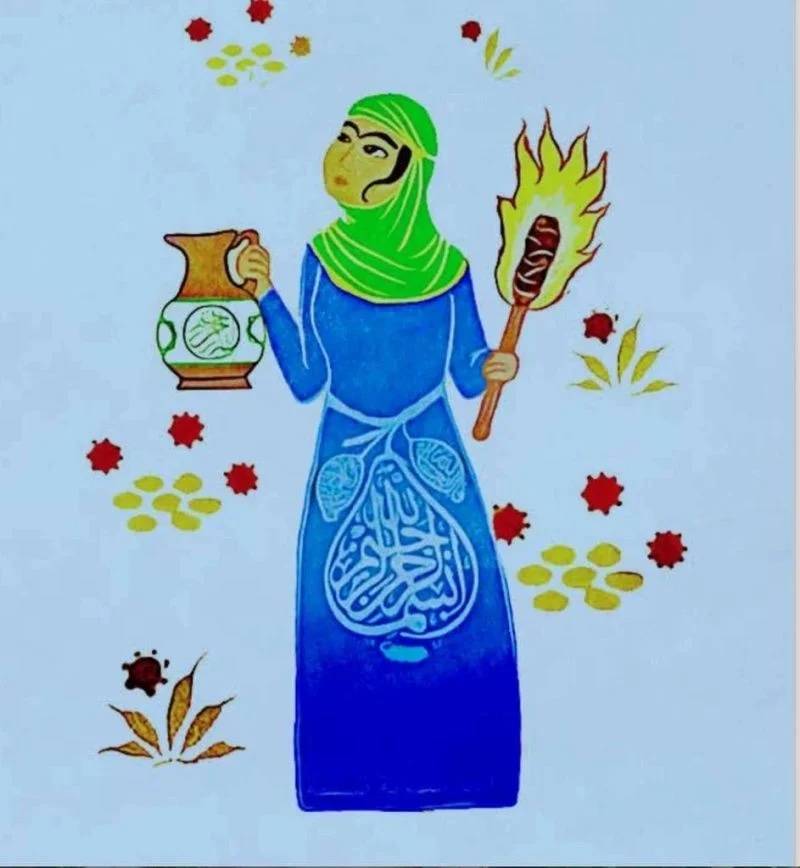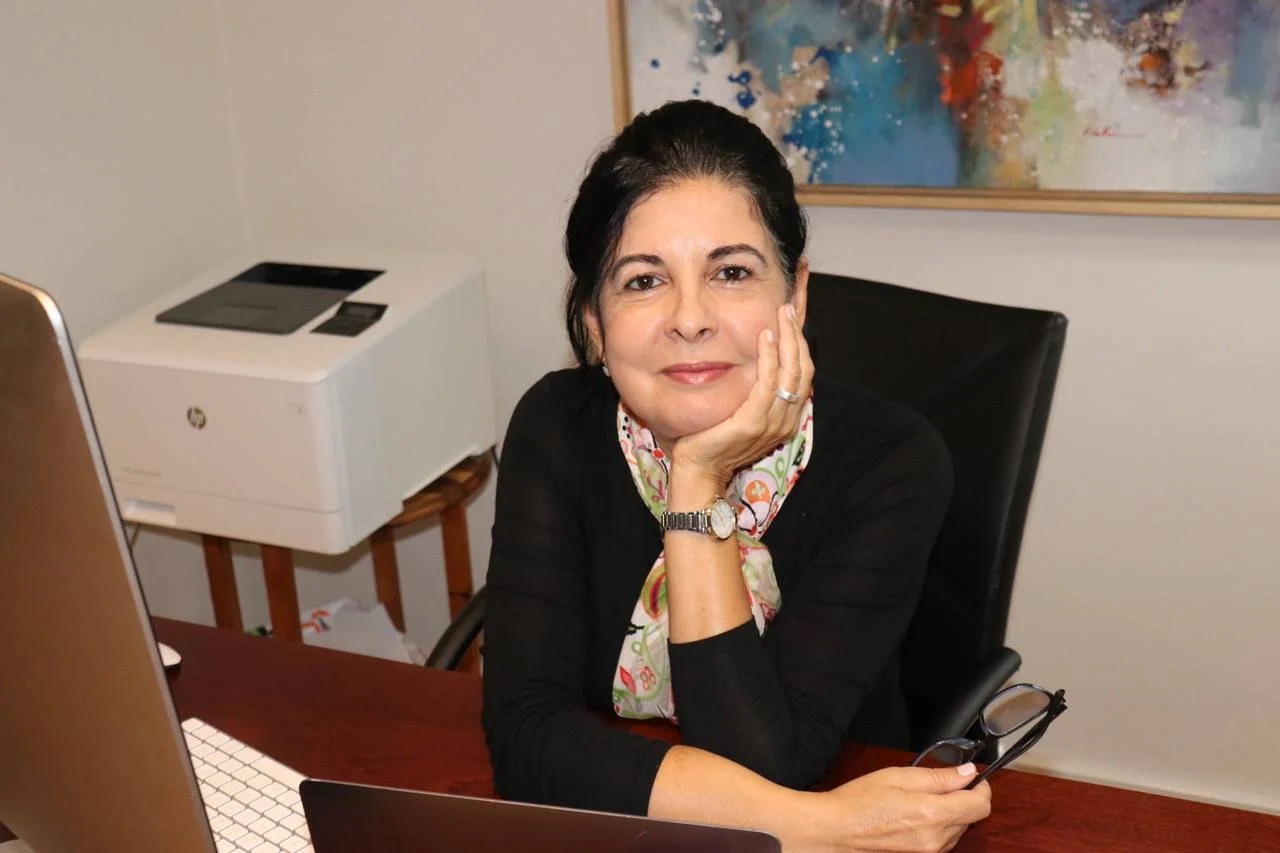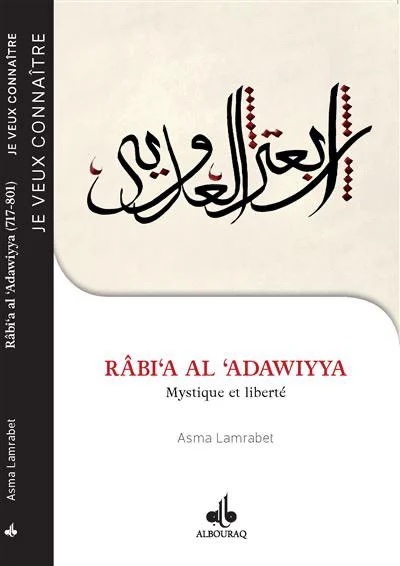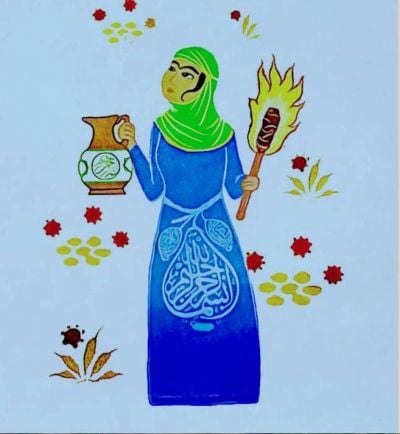
Rabiaa al-Adawiyya seen in an illumination that illustrates the work of Asma Lamrabet. (Credit: DR)
Who was Rabiaa al-Adawiyya (713-801) whom Salah Stétié, [a Lebanese writer], nicknamed “the athlete of God, similar to the future Therese,” by devoting to her a superb biography, Rabi'a, de feu et de larmes, published in 2015.
“This is the first great figure of Sufism, and it is not irrelevant that she is a woman,” Stétié said in his book.
A major figure of Sufism, endowed with a mysterious knowledge, this mystic woman and poetess lived between 714 and 801 under the Abbasid dynasty, in Basra, Iraq.
Asma Lamrabet, a Moroccan author of numerous works on reformist thought in Islam, and more particularly on the theme of women, revisits the legend of the most famous waliya (saint), with a view to relaying her universal message, which resonates with today’s world in an essay entitled “Rabi'a al-Adawiyya, mystique et liberté” [Rabiaa al-Adawiyya, mysticism and freedom], published by Albouraq, collection Je veux connaître, 2022.
 Asma Lamrabet: “Like Rabiaa al-Adawiyya, women have been 'invisibilized' from knowledge all over the world. It is important to feminize our reading of history." (Credit: DR)
Asma Lamrabet: “Like Rabiaa al-Adawiyya, women have been 'invisibilized' from knowledge all over the world. It is important to feminize our reading of history." (Credit: DR)
“I am from a generation that has seen Egyptian films. This story of a poor girl, stolen in order to be sold as a slave and turned into a dancer to survive, who only prays and then becomes a disciple of the Sufi master Hassan al-Basri (who died in 728), remained engraved in my memory as a young woman,” Asma Lamrabet, from Rabat, told L’Orient-Le Jour via a telephone call.
Albouraq, a publishing house with a focus on books on Arab-Muslim civilization, encouraged her to unravel the mystery surrounding the famous figure. Among other literary and academic references, Lamrabet is inspired by Anna-Maria Salto Sanchez’s dissertation published in 2015, as well as by the book on Adawiyya by contemporary Egyptian philosopher Abdel Rahman Badawi.
This is not to mention one of the oldest sources, The Memorial of the Saints by Farid al-Din Attar, which dates from the 12th century.
“The first things I read about her were fantastic. There are a lot of supernatural, sometimes extravagant stories about her life. I am a believer and a churchgoer, but I don’t believe in irrationality,” the writer said.
One story has it that on the way to Mecca, the Kaaba appears before Adawiyya in the middle of the desert, where she ostensibly said, “I don't want the Kaaba, I want the master of the Kaaba, what shall I do with the Kaaba?”
“I saw a subversive force in these metaphors perceived as miracles. They sought to render this woman ‘invisible’ by making her a devotee,” Lamrabet said.
In another story, Adawiyya was said to be standing in front of the Kaaba, when she made a frontal criticism of those who reduce the worship of pilgrimage to mere meaningless formalities.
“This is the idol that is worshiped on earth. Be sure of it, God has never passed through the door and has never stayed there,” she reportedly said.
Because of her spirituality, Adawiyya was able to criticize those around her and question tradition.
She was a forward thinker with an amazingly topical discourse, according to the essayist, who from 2011 to 2018 directed the Center for Women's Studies and Islam at the official religious institution al-Rabita al-Mohammadia of the ulama in Morocco.
 The cover of “Rabiaa al-Adawiyya, mystique and freedom.” (Credit: DR)
The cover of “Rabiaa al-Adawiyya, mystique and freedom.” (Credit: DR)
A model for the younger generation
By refusing numerous marriage proposals, Adawiyya broke all the taboos of patriarchal society.
“She lived in the eighth century like a Parisian woman today, refusing to submit to any authority, especially not a male one. She wanted to devote herself entirely to her love for God, which allowed her to rise to equal rank with men,” Lamrabet said.
Adawiyya received many visitors — sometimes even important mystics — in her house for spiritual vigils or political debates during which she allowed herself to express criticism.
Her great fame also attracted disciples who joined her to follow her teachings.
“Sufism at that time was a subversive reaction to what was happening in Baghdad,” Lamrabet said. “The ascetics marginalized themselves from society to denounce the excesses of pomp.”
This story sums up the essence of the spiritual doctrine of Adawiyya: a worship disinterested in all materialism except God.
“There is no worse believer than the one who worships God only out of fear of hell or desire for heaven. And if there were no hell and no heaven, you would not have worshiped Him,” Adawiyya reportedly said.
In addition to refusing money and gifts, she did not feel awkward about mixing with men.
“She is a model for our generation, which has a restrictive vision of male-female relations,” Lamrabet said.
“She succeeded in asserting herself by saying that there was no difference between the genders on a spiritual level. Her love relationship with God was so strong that it freed her from everything, giving her great freedom of language and action,” she added.
Does Adawiyya’s concern for living in harmony with nature and wild animals, loving and respecting them, make her an ecofeminist before her time?
Beyond its historical reality, this story indeed reveals a benevolent respect for all creation. Many historians attribute to her a complete abstinence from the consumption of animal products.
One story about Adawiyya goes that as she was climbing a mountain, gazelles gathered around her without showing the slightest fear, apparently feeling safe. But when her friend Hassan al-Basri came to join her, the animals ran away.
He is said to have asked her, “How come the gazelles are running away from me and not from you?”
“What did you eat today?,” Adawiyya replied.
“A dish cooked with a piece of fat,” Basri said.
“How can they not run away from you when you eat their fat?” she retorted.
A universal reading of religion
“Like Rabiaa al-Adawiyya, women have been rendered ‘invisible’ from knowledge around the world. It is important to feminize our reading of history,” Lamrabet said.
Currently director of the Chair of Gender at the Euro-Arab Foundation of the University of Granada, Lamrabet advocates for greater access for women to religious knowledge.
“The status of women is precarious everywhere. And the Middle East has the worst percentages in terms of gender inequality. Their status was decided, from the beginning of Islam, by fuqaha’ [Muslim jurists] who perpetuated the patriarchal norms and customs of Persian and Byzantine civilizations,” she explained.
To this end, the author advocates reform in interpretation and exegesis.
“It is said in the Koran that men and women have an identical soul (nafs wahida). I have been campaigning for several years for a reading that puts forward the universal values transmitted by the religious text, such as equality, justice and reason,” said Lambrabet, who is also an activist with the Human Rights Committee in Morocco.
“It is a question of human rights and social development,” she added.
The writer went on to say, “We must put an end to the legal interpretation of texts. Only a reformist, ethical and humanist reading can lead to the liberation of human beings.”
“This awareness has difficulty in emerging in Islam because of the predominance of tradition and the fear of losing one’s bearings,” she concluded, stressing that this fact would explain the identity-based withdrawal of Muslim communities in the West and in Muslim countries.
All the stories are taken from: ‘Rabi’a al-Adawiyya, mystique et liberté’ (Rabiaa al-Adawiyya, mysticism and freedom), Asma Lamrabet, Albouraq, collection Je veux connaître, 2022, Essay.
This article was originally published in French in L'Orient-Le Jour. Translation by Sahar Ghoussoub.
